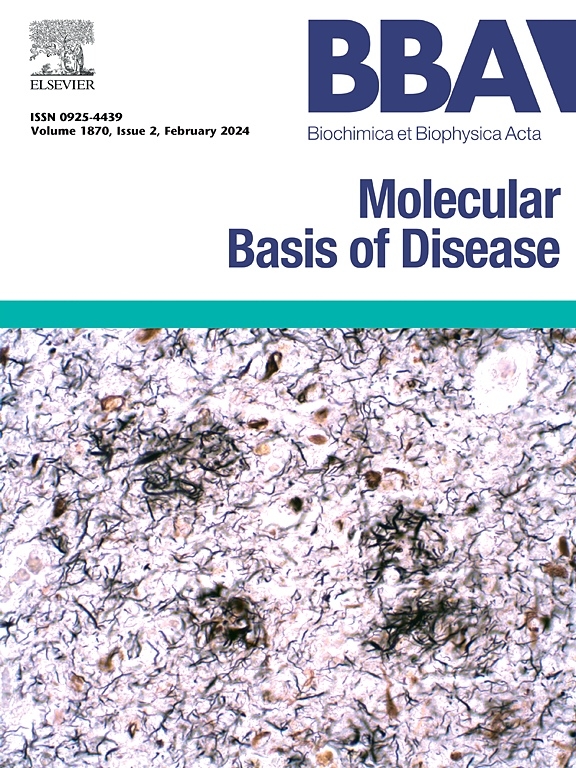抑制 PFKP 可通过调节蛋白质合成防止病理性心肌肥厚
IF 4.2
2区 生物学
Q2 BIOCHEMISTRY & MOLECULAR BIOLOGY
Biochimica et biophysica acta. Molecular basis of disease
Pub Date : 2024-10-15
DOI:10.1016/j.bbadis.2024.167542
引用次数: 0
摘要
在病理性心肌肥厚和心力衰竭(HF)过程中,代谢重编程先于大多数改变。最近的研究发现,血小板磷酸果激酶(PFKP)具有丰富的代谢和非代谢功能。在本研究中,我们探讨了 PFKP 在心脏肥大生长和 HF 中的作用。在横主动脉缩窄(TAC)手术挑战的病理性心脏重塑小鼠模型和苯肾上腺素(PE)刺激的新生大鼠心肌细胞(NRCMs)中,PFKP的表达水平均升高。在全基因 PFKP 敲除(PFKP-KO)小鼠中,TAC 手术可改善心肌肥厚,而通过静脉注射腺相关病毒 9(AAV9)在心肌肌钙蛋白 T(cTnT)启动子下过表达 PFKP 则会加重心肌肥厚和纤维化。在 NRCMs 中,采用小干扰 RNA(SiRNA)敲除或腺病毒(Adv)过表达 PFKP,对 PFKP 的干预显示出相似的表型。从机理上讲,免疫沉淀结合液相色谱-串联质谱(IP-MS/MS)分析被用来鉴定与PFKP相互作用的蛋白。真核翻译起始因子 2 亚基 beta(EIF2S2)被确定为 PFKP 的下游靶标。在 PE 刺激的 NRCM 肥大模型和小鼠 TAC 模型中,过表达 PFKP 后敲除 EIF2S2 可减少新蛋白质的合成并减轻肥大表型。我们的研究结果表明,PFKP 部分通过 EIF2S2 调节蛋白质合成参与病理性心肌肥厚,这为代谢中间产物参与信号转导提供了新的线索。本文章由计算机程序翻译,如有差异,请以英文原文为准。
PFKP inhibition protects against pathological cardiac hypertrophy by regulating protein synthesis
Metabolic reprogramming precedes most alterations during pathological cardiac hypertrophy and heart failure (HF). Recent studies have revealed that Phosphofructokinase, platelet (PFKP) has a wealth of metabolic and non-metabolic functions. In this study, we explored the role of PFKP in cardiac hypertrophic growth and HF. The expression level of PFKP was elevated both in pathological cardiac remodeling mouse model challenged by transverse aortic constriction (TAC) surgery and in the neonatal rat cardiomyocytes (NRCMs) stimulated by phenylephrine (PE). In global PFKP knockout (PFKP-KO) mice, cardiac hypertrophy was ameliorated under TAC surgery, while overexpression of PFKP by intravenous injection of adeno-associated virus 9 (AAV9) under the cardiac troponin T (cTnT) promoter worsened myocardial hypertrophy and fibrosis. In NRCMs, small interfering RNA (SiRNA) knockdown or adenovirus (Adv) overexpression of PFKP was employed and the intervention of PFKP showed a similar phenotype. Mechanistically, immunoprecipitation combined with liquid chromatography-tandem mass spectrometry (IP-MS/MS) analysis was used to identify the interacting proteins of PFKP. Eukaryotic translation initiation factor 2 subunit beta (EIF2S2) was identified as the downstream target of PFKP. In the PE-stimulated NRCM hypertrophy model and mouse TAC model, knocking down EIF2S2 after PFKP overexpression reduced the synthesis of new proteins and alleviated the hypertrophy phenotype. Our findings illuminate that PFKP participates in pathological cardiac hypertrophy partly by regulating protein synthesis through EIF2S2, which provides a new clue for the involvement of metabolic intermediates in signal transduction.
求助全文
通过发布文献求助,成功后即可免费获取论文全文。
去求助
来源期刊
CiteScore
12.30
自引率
0.00%
发文量
218
审稿时长
32 days
期刊介绍:
BBA Molecular Basis of Disease addresses the biochemistry and molecular genetics of disease processes and models of human disease. This journal covers aspects of aging, cancer, metabolic-, neurological-, and immunological-based disease. Manuscripts focused on using animal models to elucidate biochemical and mechanistic insight in each of these conditions, are particularly encouraged. Manuscripts should emphasize the underlying mechanisms of disease pathways and provide novel contributions to the understanding and/or treatment of these disorders. Highly descriptive and method development submissions may be declined without full review. The submission of uninvited reviews to BBA - Molecular Basis of Disease is strongly discouraged, and any such uninvited review should be accompanied by a coverletter outlining the compelling reasons why the review should be considered.

 求助内容:
求助内容: 应助结果提醒方式:
应助结果提醒方式:


